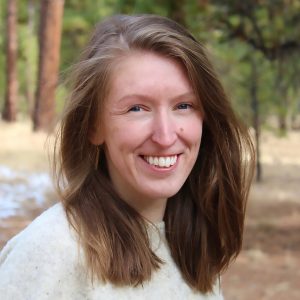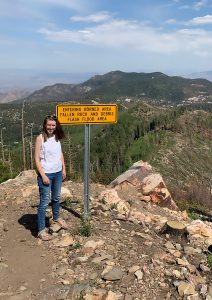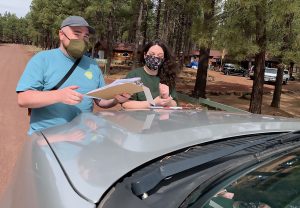Fairness First blog
Researchers voices in health equity
The Fairness First blog represents a space where researchers share with the broader community why health equity research matters to them, how do they connect to health equity, and what is the value of community engagement in the research process.
Sept. 29, 2021
Wildfires and health equity with Catrin Edgeley
Assistant Professor, School of Forestry
 Catrin Edgeley is an Assistant Professor of Natural Resource Sociology in the School of Forestry at Northern Arizona University. Her research focuses on wildfire social science, including how communities adapt to wildfire risk and impacts across diverse local contexts. She has spent time researching and learning from numerous communities impacted by recent wildfires across the West, including Paradise, CA after the 2018 Camp Fire. Her research involves a broad range of methods, ranging from interviews and focus groups to surveys and Q-methodology. Cat is currently an Early Career Innovator Fellow with the National Center for Atmospheric Research and PI on a Pilot Project with the Southwest Health Equity Research Collaborative. Cat earned her Ph.D. in Natural Resources from the University of Idaho, and her MSc in Risk and Environmental Hazards and BSc in Geography from Durham University in the United Kingdom.
Catrin Edgeley is an Assistant Professor of Natural Resource Sociology in the School of Forestry at Northern Arizona University. Her research focuses on wildfire social science, including how communities adapt to wildfire risk and impacts across diverse local contexts. She has spent time researching and learning from numerous communities impacted by recent wildfires across the West, including Paradise, CA after the 2018 Camp Fire. Her research involves a broad range of methods, ranging from interviews and focus groups to surveys and Q-methodology. Cat is currently an Early Career Innovator Fellow with the National Center for Atmospheric Research and PI on a Pilot Project with the Southwest Health Equity Research Collaborative. Cat earned her Ph.D. in Natural Resources from the University of Idaho, and her MSc in Risk and Environmental Hazards and BSc in Geography from Durham University in the United Kingdom.
Q. Can you tell us more about the research you do around wildfire and social science?
A. I research how human communities can become “fire adapted” (i.e., live with fire while minimizing impacts and losses) before, during, and after wildfires. This involves using a suite of social science methods, including interviews, focus groups and surveys, to gather data with and for communities at risk to determine successful adaptation strategies.
This can include household-level actions that improve health and safety like improving indoor air quality or developing evacuation plans, detangling community conflicts around forest management or post-fire recovery, and support or opposition for different policies that may impact social adaptation to fire.
Socially impactful wildfires are now occurring more frequently, so working proactively to identify actions and approaches that minimize losses and health impacts across different scales and contexts is increasingly time sensitive.
Q. At what moment in your life did you realize, “This is the type of research I want to do”?
A. The first case study I conducted during my Ph.D. research uncovered the difficulties rural communities faced when trying to access disaster assistance after the 2014 Carlton Complex Fire in Washington. Walking burned properties, hearing descriptions of belongings, connections, and communities lost, standing in newly rebuilt houses talking about how this no longer felt like home; these interviews were the first time I was observing fire impacts directly and the affects they had on households and communities.
Listening to these stories and weaving them together to build a comprehensive picture of rural challenges to accessing disaster recovery assistance underscored the importance of elevating local experiences into policy and management conversations to make a difference for future communities affected by fire. I had been interested in wildfire social science for several years at that point, but this study lay the foundation for my interest in understanding social impacts specifically.
Now, moments of motivation are found in conversations with practitioners and community members and we identify ways in which findings can be implemented to elevate community safety or cohesion.
Q. What is the element of “unfairness” or “inequity” surrounding the social impacts of wildfires that you are examining in your research (in the broad context of health and wellbeing)?
A. Wildfire impacts to people have consistently been documented as unequally distributed, both between and within communities. My SHERC Pilot Project examines how inequities emerge or are exacerbated by smoke from both wildfires and fire used to achieve forest management objectives (e.g., prescribed fire or slash pile burning).
Smoke can broadly be characterized as an environmental justice issue, particularly when it is caused by forest management activities to reduce fire risk. Those who benefit from management outcomes are often not impacted by smoke; a good example might be a prescribed fire near Flagstaff that protects a neighborhood from future wildfires but blows smoke down into Sedona, Cottonwood, or Camp Verde causing reduced air quality.
Regardless of smoke source, reduced air quality may translate to a higher incidence of health issues or hospital visits for more vulnerable residents.
Q. How do you see your work helping to push the needle on this issue towards “fairness” or “equity”? In other words, how is your work advancing health equity for people most vulnerable to wildfire impacts?
A. We have been busy this summer collecting survey and interview data that lay the foundation for understanding the “adaptive capacity” of households to fire-caused smoke. That means characterizing households (for example, do members have a pre-existing health condition?
Do they have the means to leave if air quality gets hazardous?), identifying resources available to them, and then determining which potential adaptive actions align best with local culture and attitudes towards smoke. One goal of this research is to capture support or opposition for different programs or mechanisms for reducing household smoke impacts so that we can streamline resource allocation in heavily affected communities.
That means knowing who is most vulnerable to potential health impacts from smoke, and providing them with a solution that works best with their lifestyle to begin leveling the playing field on access to healthy air quality during fire events.
Q. How do you want your research to make a difference or change in this world? (Think short-term and long-term.)
A. The importance of acknowledging and supporting socially diverse needs in communities that have fire risk has been consistent throughout my research to date. Recognizing that there is no “one size fits all” approach to becoming fire adapted or to reducing health risks associated with fire is critical, regardless of location or population.
I hope my research can contribute to more nuanced discussions, policies, and management strategies that incorporate consideration of differences from household to household and community to community. That can lead to faster adoption of adaptation strategies, proactive documentation and remediation of health inequities, and collective efforts to reduce risk within communities.
Q. What is one important lesson you’ve learned about yourself and this region through your research?
A. Many of the communities I work with in Arizona are rural, and often don’t receive media attention, disaster assistance, or consideration in conversations about adaptation after wildfire once the fire is out. Research for my SHERC Pilot Project underscored the value that communities see in research as a platform to voice their concerns, ask questions, and motivate change in arenas they may not have access to. In the absence of platforms to share concerns, the communities we studied had looked inward to build informal support systems that helped protect more vulnerable community members.
My big takeaway from this: don’t underestimate the power communities have to internally address their own self-identified health inequities in the absence of external assistance, and use your research to elevate their voices so that they can be supported as they develop pathways forward.
You can connect with Dr. Catrin Edgeley at Catrin.Edgeley@nau.edu to learn more about her work and potential collaboration opportunities.
Back to the main Fairness First Campaign page.



